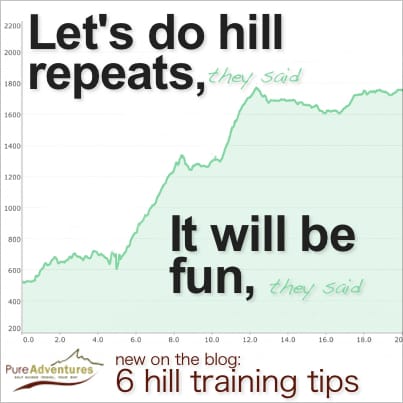Hill training is most often associated with road bike racing and not with self-guided cycling tours. After all, don’t most cyclists want a flat and leisurely route to ride on during their European bike tour? As with all our tours, we strongly suggest plenty of time in the saddle – and yes, hill training – for self-guided travelers to comfortably finish trips with extremely hilly routes (keeping in mind that most of our tours are suitable for athletes of all abilities).
Still want to take on the mountains in Europe? We’ve searched out the best hill training tips for road cyclists and share them here.
Embrace hill repeats
The basis of any hill training program is hill repeats. BikeRadar suggests starting with 8 repeats on a hill that has three distinct phases (10% grade; flattens out; 12% grade). “Sprint at the start of the hill, sit down and change down on the flatter part, and then have an all-out sprint out of the saddle to the top,” advises BikeRadar expert Dave Lloyd. Record your times for each repeat, trying to maintain the same speed on each repeat. “If you fade badly, stop the exercise, warm down and try again the next week,” Lloyd says.
Practice seated climbs
Your legs may be aching and your backside hurting, but by sitting in the saddle for as much of the climb as possible, you’re more aerobically efficient. “Sitting back in the saddle will recruit your glutes, giving the large muscles at the back of your thighs more leverage to pedal,” says Andy Cook with CyclingPlus. When you get to the top of the hill, then stand in your pedals to give yourself a break.
Strengthen your core muscles
“Often, it isn’t the legs that give out on long climbs, but the back,” says Gale Bernhardt with Active.com. When you are cycling on hills, your back is in a different position, and on a particularly hilly route, that could lead to back pain and spasms. Pilates, yoga and other core strengthening and stabilizing activities need to be a part of of your hill training routine.
Build strong legs
It goes without saying that you’ll need to build leg strength to conquer cycling climbs, but cyclist and personal trainer Tracy Draper has a few exercises that don’t involve hitting the gym. Walking lunges, plyometrics and leg lifts are equipment-free ways that desk-bound athletes can incorporate strength training into their cycling training. “Obviously, real endurance is optimally built by putting in the time on the bike but this can help if you are confined to a chair for multiple hours a day,” says Draper on her blog Cycling With Tracy.
Lose weight
“The power-to-weight ratio is cycling’s great leveler. It’s a measure that allows a comparison of cyclists’ abilities even when the riders vary in size,” writes Chris Carmichael on Bicycling.com. So what does this have to do with cycling and hill training? The heavier you are, the harder it will be to power over Piedmont’s hills. Calling it formula for faster hill riding, Carmichael shares a real life example how dropping a few pounds ups your pedal power and speed on his blog.
Include surges and speed work on your trainer
For cyclists who don’t have hills nearby or are training for a spring cycling tour, including speed work on your trainer is the ticket to tackling climbs. By training at (or just below) your lactate threshold, you improve your ability to power through the last few minutes of a steep climb. In one of his training posts on Bicycling.com, trainer Chris Carmichael outlines a No-climbing workout you can do on your trainer twice a week.

